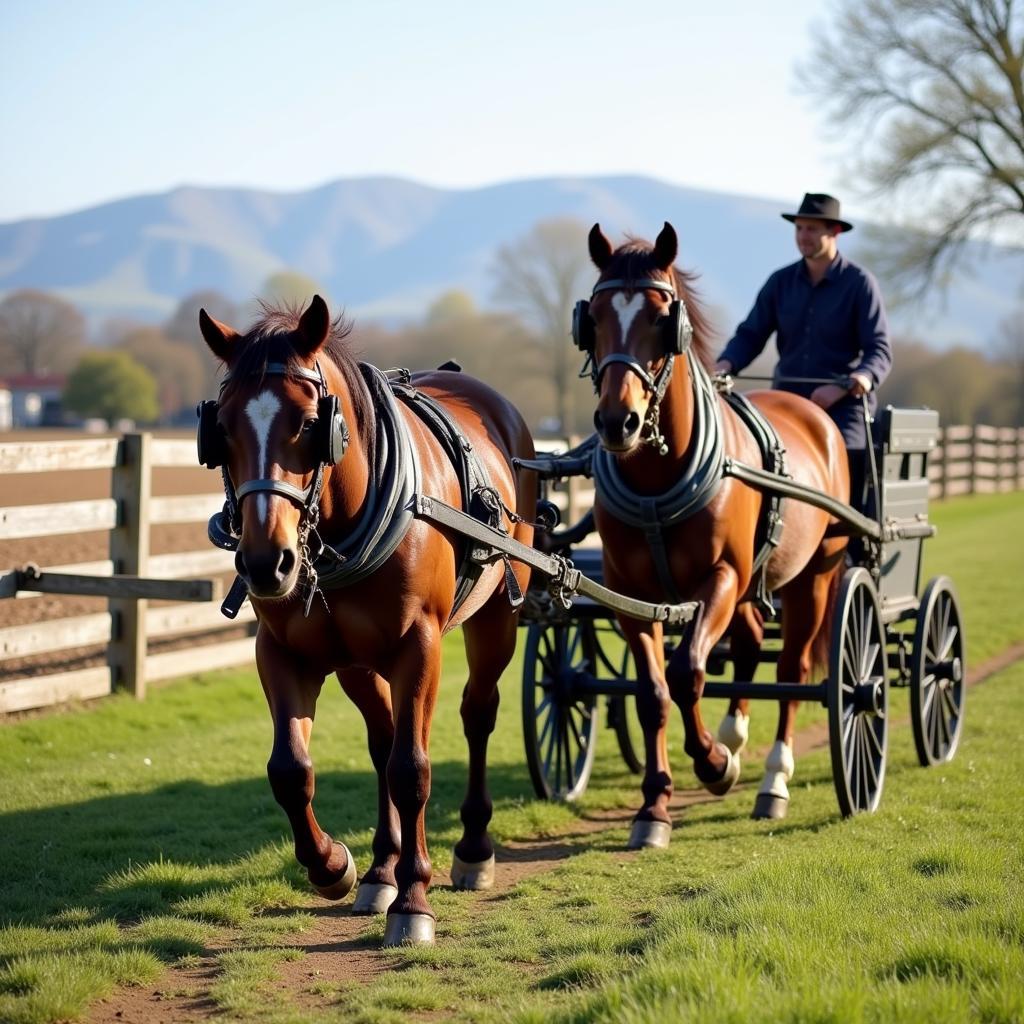Hershberger Horses, with their distinctive long manes and flowing tails, are a captivating breed deeply rooted in Amish and Mennonite traditions. These gentle giants are more than just beautiful animals; they are a testament to a life of hard work, simplicity, and dedication to heritage. This article delves into the fascinating world of Hershberger horses, exploring their history, characteristics, care, and the unique cultural significance they hold.
The History and Heritage of Hershberger Horses
The Hershberger horse story begins with the Amish and Mennonite communities of North America, particularly in Ohio, Pennsylvania, and Indiana. These groups, known for their simple living and rejection of modern technology, relied heavily on horses for transportation, farming, and other daily tasks. The Hershberger horse, named after the Amish bishop Daniel Hershberger, emerged as a preferred breed due to their strength, calm temperament, and willingness to work. They became an integral part of the Amish and Mennonite way of life, symbolizing their commitment to tradition and practicality.
 Hershberger Horse Working on an Amish Farm
Hershberger Horse Working on an Amish Farm
Distinguishing Characteristics of the Hershberger Horse
Hershberger horses are often confused with other draft breeds, but several key characteristics set them apart. Their most prominent feature is their long, flowing manes and tails, which are never trimmed, reflecting the Amish belief in letting nature take its course. They are typically solid-colored, with black, bay, and chestnut being the most common. Their build is strong and muscular, ideal for heavy work, and they possess a generally calm and gentle disposition. Their average height ranges from 15 to 17 hands high.
Caring for a Hershberger Horse
While their low-maintenance nature is appealing, Hershberger horses still require specific care to thrive. Their diet should consist primarily of good quality hay, supplemented with grains and minerals as needed. Regular hoof care is crucial, as is grooming, particularly for their long manes and tails to prevent tangles and matting. Like all horses, they need regular veterinary checkups and vaccinations.
Specific Health Considerations for Hershberger Horses
While generally healthy and hardy, Hershberger horses, like other draft breeds, can be prone to certain health issues. These include respiratory problems, joint issues, and laminitis. Regular veterinary care and a balanced diet are essential for preventing and managing these conditions.
The Cultural Significance of the Hershberger Horse
Beyond their practical use, Hershberger horses hold deep cultural significance within Amish and Mennonite communities. They represent a connection to their ancestors, a symbol of their self-sufficiency, and a testament to their simple way of life. The horses are often seen pulling buggies, the primary mode of transportation for these communities, further reinforcing their integral role in their culture.
Are Hershberger Horses Right for You?
If you are considering owning a Hershberger horse, it’s essential to understand their specific needs and temperament. Their gentle nature makes them suitable for both experienced and novice horse owners, but their size and strength require careful handling. Their deep-rooted connection to Amish and Mennonite culture also necessitates respect for the traditions associated with the breed.
Conclusion
Hershberger horses are more than just a breed; they are a living embodiment of tradition, hard work, and a simpler way of life. Their unique characteristics, gentle nature, and cultural significance make them a truly captivating breed. Understanding their history, care requirements, and the values they represent is crucial for anyone considering bringing a Hershberger horse into their life.
FAQs
- What is the average lifespan of a Hershberger horse? (A: 25-30 years)
- How tall are Hershberger horses? (A: 15-17 hands high)
- What are the most common colors of Hershberger horses? (A: Black, bay, and chestnut)
- Are Hershberger horses good for beginners? (A: Their gentle nature makes them suitable for beginners with proper guidance.)
- What are the specific health concerns for Hershberger horses? (A: Respiratory issues, joint problems, and laminitis.)
- Why are their manes and tails never cut? (A: This practice reflects the Amish belief in allowing nature to take its course.)
- Where can I find more information about Hershberger horses? (A: Contact us, or check out our other articles on our website.)
Common Scenarios and Questions:
-
Scenario: You are interested in purchasing a Hershberger horse but are unsure where to start. Question: Where can I find reputable breeders of Hershberger horses?
-
Scenario: You own a Hershberger horse and notice it has developed a cough. Question: What are the common respiratory ailments in Hershberger horses, and what should I do?
-
Scenario: You want to learn more about Amish and Mennonite traditions related to horse care. Question: What are some recommended resources for learning about the cultural significance of Hershberger horses?
Further Reading and Resources:
- Explore our other articles on draft horse breeds.
- Learn more about Amish and Mennonite traditions.
- Discover the history of various horse breeds.
For any assistance or further information, please contact us at Phone Number: 0772127271, Email: [email protected] or visit us at QGM2+WX2, Vị Trung, Vị Thuỷ, Hậu Giang, Việt Nam. We have a 24/7 customer service team available to assist you.